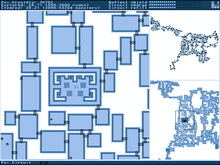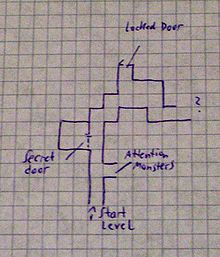Card (computer game)
As a map or Map (Engl.) Is known in computer games a cartographic representation of the gaming environment, which serves as an orientation. The term is often used in a figurative sense for the game environment itself, see level (game section) .
Types of cards in computer games
The maps can be two- or three-dimensional (the latter especially in space games , e.g. X-Wing ) and in their design and complexity range from simple floor plans (e.g. Doom ) to precise models of the game environment ( e.g. Operation Flashpoint ) showing the topography , vegetation and parts of the infrastructure . Usually, however, the objects are viewed from a top view.
Depending on the level of reality, the map can also contain a correct coordinate system that the player must / can use in order to be able to cope with tasks in the game. In flight simulations, special attention is paid to a realistic map layout, so that such maps may correspond very precisely to the correct navigation maps.
You can also distinguish between two groups, depending on the type of card:
- Many games provide the user with a complete overview of the game environment (the game world) right from the start.
- Other games, e.g. B. role-playing games , initially only show the player the part of the environment that his character can see in the game. The player must first explore his environment in order to see further information on the map. The card has the function of a self-drawn plan, which is always expanded as far as the character has advanced in the game world. This automatic mapping is known as automapping . This avoids having information available at the beginning of the game that could simplify the rest of the game too much. In many strategy games , areas that have already been explored become invisible again, both on the map and in the game view, if the player is not represented there with his own units ( fog of war ).
The function of automapping was relatively rare until the 1980s. Without this function, the player then had to make the cards himself , for example on squared paper , since role-playing games in particular are often equipped with nested dungeons . Well-known games without automap include Wizardry , Might and Magic and Eye of the Beholder .
Another special feature is that in some games the current position of the player's own character and that of the (already sighted) opponents are displayed with symbols on the map. The representation of the game world thus becomes an animated map that can reproduce virtual reality in real time. At higher levels of difficulty, this representation of the actors can be suppressed in some games (e.g. in Operation Flashpoint ).
An interactive 2D map on the edge of the game that adapts to the position of the player is also known as a minimap or mini-map . It is often presented as part of a head-up display . Other games have their own map menu for this purpose or offer them as an item . Especially when playing games in the isometric perspective , the boundaries between the map and the game world are blurred because they are presented in a similar manner.
Functions of a card in a computer game
The functions of a card can be divided into:
- a navigation function , for example through route planning or a compass (especially in role-playing games as a mini map and in racing games as a route plan )
- the display of moving objects ( radar ) , for example about opponents, non-player characters and fellow players or conflicts in the game world (especially in shooters and strategy games )
- the display of important information about the game environment (e.g. resources , upcoming quests , economic factors and accessible buildings). These factors can be to some levels filter. (especially in | strategy, building simulation and role-playing games)
- give a rough overview and orientation of the game world (often the map can be moved, rotated or certain sections enlarged or reduced)
- Fast travel functions to get there directly by clicking on a position on a map (especially in role-playing games)
Controversy and criticism
In online first person shooters , a map offers decisive strategic and tactical advantages, which is why many players see it as an integral part of it. The game Call of Duty: Modern Warfare came under criticism because it did without this function in the beta. The use of map functions also depends on the genre and setting.
A cheat that equips the card of a game with several functions that are not provided by the game (Maphack) can give it a decisive and unfair advantage over fellow players, which is particularly problematic in e-sports .
development
Maps can be created using a map editor . Some of them are included in games or can be downloaded as an external program. The development of map systems for a computer game is similar to that of a virtual navigation and radar system, with the difference that the positions and states of game objects are read out.
Individual evidence
- ↑ Scott Rogers: Level Up! The Guide to Great Video Game Design . John Wiley & Sons, 2014, ISBN 978-1-118-87719-7 , pp. 221 ff . ( google.de [accessed on January 22, 2020]).
- ^ Rachel Kowert: Video Games and Well-being: Press Start . Springer Nature, 2019, ISBN 978-3-03032770-5 , pp. 37–49 ( google.de [accessed January 22, 2020]).
- ↑ a b The story of the dungeon crawler: Go underground! July 27, 2019, accessed January 22, 2020 .
- ^ Ernest Adams: Fundamentals of Game Design . New Riders, 2013, ISBN 978-0-13-343571-9 ( google.com [accessed January 22, 2020]).
- ^ Todd Barron: Strategy Game Programming with DirectX 9.0 . Wordware Publishing, Inc., 2003, ISBN 978-1-55622-922-0 ( google.de [accessed January 22, 2020]).
- ↑ Off With Their HUDs !: Rethinking the Heads-Up Display in Console Game Design. Retrieved January 22, 2020 (English).
- ^ Mark JP Wolf: Encyclopedia of Video Games: AL . ABC-CLIO, 2012, ISBN 978-0-313-37936-9 , pp. 378 ff . ( google.de [accessed on January 22, 2020]).
- ↑ Guy W. Lecky-Thompson: Video Game Design Revealed . Cengage Learning, 2008, ISBN 978-1-58450-607-2 , pp. 202–203 ( google.de [accessed January 22, 2020]).
- ↑ "Modern Warfare": Developers respond to mini-map controversy in beta. September 13, 2019, accessed January 22, 2020 .
- ↑ Urban Dictionary: Map Hack. Retrieved January 22, 2020 (American English).

